Moving observer
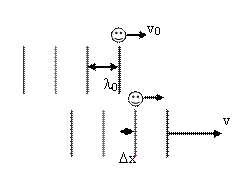 Suppose a stationary source is generating sound
waves with frequency f0 = 240 Hz (middle C) and
wavelength λ0 = v/f0. A stationary
observer a certain distance from the source will hear a sound
with pitch f0. 240 times each second the
observer's eardrum will be pushed in and pulled out as pressure
crest and pressure trough reach the ear. The time period
between two consecutive crests is T = 1/f0 = (1/240)
s. Assume the observer gets onto a motorcycle and starts
driving away from the source. Assume that at time t1
a pressure crest reaches the ear at position x. The next
crest will be at position x at time t1 + T. But
the ear is no longer there. The observer has moved.
The crest has to travel an extra distance before it reaches the
ear. This takes an extra time interval ∆t. The time
interval between successive crests reaching the ear of the
observer now is T' = T + ∆t.
Suppose a stationary source is generating sound
waves with frequency f0 = 240 Hz (middle C) and
wavelength λ0 = v/f0. A stationary
observer a certain distance from the source will hear a sound
with pitch f0. 240 times each second the
observer's eardrum will be pushed in and pulled out as pressure
crest and pressure trough reach the ear. The time period
between two consecutive crests is T = 1/f0 = (1/240)
s. Assume the observer gets onto a motorcycle and starts
driving away from the source. Assume that at time t1
a pressure crest reaches the ear at position x. The next
crest will be at position x at time t1 + T. But
the ear is no longer there. The observer has moved.
The crest has to travel an extra distance before it reaches the
ear. This takes an extra time interval ∆t. The time
interval between successive crests reaching the ear of the
observer now is T' = T + ∆t.
While the observer has traveled a
distance ∆x = vobs(T + ∆t),
the wave has traveled a distance ∆x + λ0 = v(T + ∆t).
Equating the two expressions for ∆x we obtain
vobsT + vobs∆t = vT + v∆t - λ0,
and, using λ0 = v/f0 = vT we have
vobsT + vobs∆t = v∆t or ∆t = vobsT/(v
- vobs).
T' = T + vobsT/(v - vobs) = vT/(v - vobs),
f' = 1/T' = f0(v - vobs)/v.
The observer hears a sound with pitch f' < f0.
The period has increased, the apparent
frequency of the wave has decreased, the pitch has decreased. The
observer hears a note lower than middle C. This is an example of the
Doppler effect.
Velocity is a vector. Let vobs be the components of the
observer's velocity along the direction of the velocity of the sound
reaching the observer. Then vobs is positive if the
observer moves away from the source and vobs is
negative if the observer moves towards the source. With this sign
convention
f' = f0(v - vobs)/v also gives the
frequency f' heard by an observer moving towards the source.
If the observer is driving towards the source, then the time interval between successive
crests reaching the ear will be shorter than T. Assume that at time t1
a pressure crest reaches the ear at position x. The next crest will be
at position x at time t1 + T. But it will reach the ear before it reaches position x,
because the observer is moving towards the source. The observer hears a
note higher than middle C.
The apparent frequency of the sound wave
reaching the observer is
f' = f0(v - vobs)/v=
f = f0(v + |vobs|)/v.
f' > f0, the observer hears a higher frequency sound.
We usually do not notice the Doppler effect when moving around on foot, because the speed
of sound is so much greater than our speed. But moving on a motorcycle
at 55 miles/h = 24.6 m/s towards a source, we have f = f0(340 + 24.6)/340
= 1.07 f0. Moving away from the source we have f = f0(340
- 24.6)/340 = 0.93 f0. As we drive by the source, the
perceived pitch therefore changes by approximately 14%, a noticeable
change.
Moving Sources
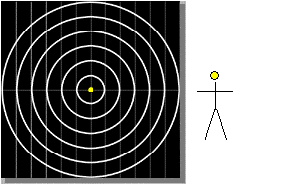 The perceived pitch of a sound wave also changes if the observer is
stationary and the source is moving. Let vs be the
components of the source's velocity along the direction of the velocity
of the sound reaching the observer. Then vs is positive
if the source moves towards the observer and vs is
negative if the source moves away from the observer. The apparent frequency of the sound wave reaching the observer
is
The perceived pitch of a sound wave also changes if the observer is
stationary and the source is moving. Let vs be the
components of the source's velocity along the direction of the velocity
of the sound reaching the observer. Then vs is positive
if the source moves towards the observer and vs is
negative if the source moves away from the observer. The apparent frequency of the sound wave reaching the observer
is
f' = f0v/(v - vs).
In the figure on the right the rings denote successive crests of the
sound wave. The time interval between the emission of successive crests
is T. The larger the ring, the earlier is the time of emission. All
the rings expand with the same speed, the speed of sound in the medium.
If the observer is stationary, then the time interval between the
arrival of successive rings at the ear is T.
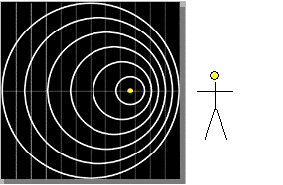 In the next figure the source is moving towards the
observer. The center of each ring is at the position of the source
at the time it emits the crest. Since the source is moving towards
the right, the center of successive rings moves towards the right.
If the observer is stationary, then the time interval between the
arrival of successive rings at the ear is less than T.
In the next figure the source is moving towards the
observer. The center of each ring is at the position of the source
at the time it emits the crest. Since the source is moving towards
the right, the center of successive rings moves towards the right.
If the observer is stationary, then the time interval between the
arrival of successive rings at the ear is less than T.
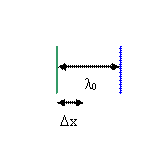 In the time interval T the wave travels a distance λ0
and the source travels a distance ∆x.
In the time interval T the wave travels a distance λ0
and the source travels a distance ∆x.
λ0/v = ∆x/vs.
The wavelength at the observer is λ' =
λ0 - ∆x =
λ0 - λ0vs/v
= λ0 (v - vs)/v.
f' = v/λ' = (v/λ0)[v/(v
- vs)] = f0v/(v - vs).
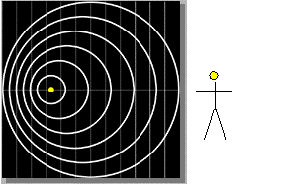 In the next figure the source is moving away from the
observer. Since the source is moving towards the left, the center
of successive rings moves towards the left. If the observer is
stationary, then the time interval between the arrivals of successive
rings at the ear is greater than T.
In the next figure the source is moving away from the
observer. Since the source is moving towards the left, the center
of successive rings moves towards the left. If the observer is
stationary, then the time interval between the arrivals of successive
rings at the ear is greater than T.
The apparent frequency of the sound wave reaching the observer
is
f' = f0v/(v - vs) = f0v/(v + |vs|).
Please click here to for an interactive visualization of sound waves close to a
cylindrical speaker.
Compare sound wave with different wavelengths, produced when the speaker is at
rest and when it is moving.
Whenever the source and the observer move with
respect to each other, the wavelength of the sound reaching the ear will
be Doppler shifted. But the formula for the Doppler shift depends on
who is moving, the source or the observer. If the source is moving
towards the observer with a speed close to the speed of sound, then the
wavelength of the sound reaching the ear becomes very short and the
pitch becomes very high. In the formula, f' = f0v/(v - vs), the denominator gets
very small. When vs = v , the denominator is zero, so f'
becomes infinite. A sonic boom is
produced at the location of the observer.
If both source and observer are in motion, then
the apparent frequency of the sound wave reaching the observer is
f' = f0(v - vobs)/(v - vs)
where vobs and vs are
not the speeds, but the components of the observer's and the
source's velocity in the direction of the velocity of the sound reaching
the observer.
f' increases if the source and the observer
approach each other and decreases if they recede from each other.
Links:
Problem:
A train has a whistle, which emits a 400 Hz sound. You are stationary
and you hear the whistle, but the pitch is 440 Hz. How fast is train moving
towards or away from you?
Solution:
- Reasoning:
The pitch is higher, so the train is moving towards you.
Its speed relative to you is found from f = f0v/(v-vs).
- Details of the calculation:
We have (v-vs) = f0v/f = (400/s)(340
m/s)/(440/s) = 309 m/s.
Therefore vs = 340 m/s-309 m/s = 31 m/s = 69 mph.
vs is positive, the train is moving in the direction of the
sound, towards you.
Problem:
Two eagles fly directly toward one another, the first at 15.0 m/s and the
second at 20.0 m/s. Both screech, the first one emitting a frequency of
3200 Hz and the second one emitting a frequency of 3800 Hz. What
frequencies do they receive if the speed of sound is 330 m/s?
Solution:
- Reasoning:
Both source and observer are in motion, so f = f0(v - vobs)/(v - vs).
- Details of the calculation:
(i) The first eagle is the source, the second the observer. Then
vs = 15 m/s, vobs = -20 m/s, f0 = 3200/s.
The second eagle hears a screech with frequency f = 3200/s*(330 + 20)/(330 -
15) = 3556/s.
(i) The second eagle is the source, the first the observer. Then
vs = 20 m/s, vobs = -15 m/s, f0 = 3800/s.
The
first eagle hears a screech with frequency f = 3800/s*(330 + 15)/(330 -
20) = 4229 s.
The Doppler effect is a phenomenon observed with all waves. It
is named for the Austrian scientist
Christian Doppler (1803-1853). Whenever a source generating a wave moves
relative to an observer or an observer moves relative to a source, the frequency
of the wave at the location of the observer is shifted relative to the frequency
of the source. The frequency at the location of the observer increases when the
source and observer are approaching each other and decreases when they are
moving away from each other.
 Suppose a stationary source is generating sound
waves with frequency f0 = 240 Hz (middle C) and
wavelength λ0 = v/f0. A stationary
observer a certain distance from the source will hear a sound
with pitch f0. 240 times each second the
observer's eardrum will be pushed in and pulled out as pressure
crest and pressure trough reach the ear. The time period
between two consecutive crests is T = 1/f0 = (1/240)
s. Assume the observer gets onto a motorcycle and starts
driving away from the source. Assume that at time t1
a pressure crest reaches the ear at position x. The next
crest will be at position x at time t1 + T. But
the ear is no longer there. The observer has moved.
The crest has to travel an extra distance before it reaches the
ear. This takes an extra time interval ∆t. The time
interval between successive crests reaching the ear of the
observer now is T' = T + ∆t.
Suppose a stationary source is generating sound
waves with frequency f0 = 240 Hz (middle C) and
wavelength λ0 = v/f0. A stationary
observer a certain distance from the source will hear a sound
with pitch f0. 240 times each second the
observer's eardrum will be pushed in and pulled out as pressure
crest and pressure trough reach the ear. The time period
between two consecutive crests is T = 1/f0 = (1/240)
s. Assume the observer gets onto a motorcycle and starts
driving away from the source. Assume that at time t1
a pressure crest reaches the ear at position x. The next
crest will be at position x at time t1 + T. But
the ear is no longer there. The observer has moved.
The crest has to travel an extra distance before it reaches the
ear. This takes an extra time interval ∆t. The time
interval between successive crests reaching the ear of the
observer now is T' = T + ∆t. The perceived pitch of a sound wave also changes if the observer is
stationary and the source is moving. Let vs be the
components of the source's velocity along the direction of the velocity
of the sound reaching the observer. Then vs is positive
if the source moves towards the observer and vs is
negative if the source moves away from the observer. The apparent frequency of the sound wave reaching the observer
is
The perceived pitch of a sound wave also changes if the observer is
stationary and the source is moving. Let vs be the
components of the source's velocity along the direction of the velocity
of the sound reaching the observer. Then vs is positive
if the source moves towards the observer and vs is
negative if the source moves away from the observer. The apparent frequency of the sound wave reaching the observer
is  In the next figure the source is moving towards the
observer. The center of each ring is at the position of the source
at the time it emits the crest. Since the source is moving towards
the right, the center of successive rings moves towards the right.
If the observer is stationary, then the time interval between the
arrival of successive rings at the ear is less than T.
In the next figure the source is moving towards the
observer. The center of each ring is at the position of the source
at the time it emits the crest. Since the source is moving towards
the right, the center of successive rings moves towards the right.
If the observer is stationary, then the time interval between the
arrival of successive rings at the ear is less than T. In the time interval T the wave travels a distance λ0
and the source travels a distance ∆x.
In the time interval T the wave travels a distance λ0
and the source travels a distance ∆x. In the next figure the source is moving away from the
observer. Since the source is moving towards the left, the center
of successive rings moves towards the left. If the observer is
stationary, then the time interval between the arrivals of successive
rings at the ear is greater than T.
In the next figure the source is moving away from the
observer. Since the source is moving towards the left, the center
of successive rings moves towards the left. If the observer is
stationary, then the time interval between the arrivals of successive
rings at the ear is greater than T.